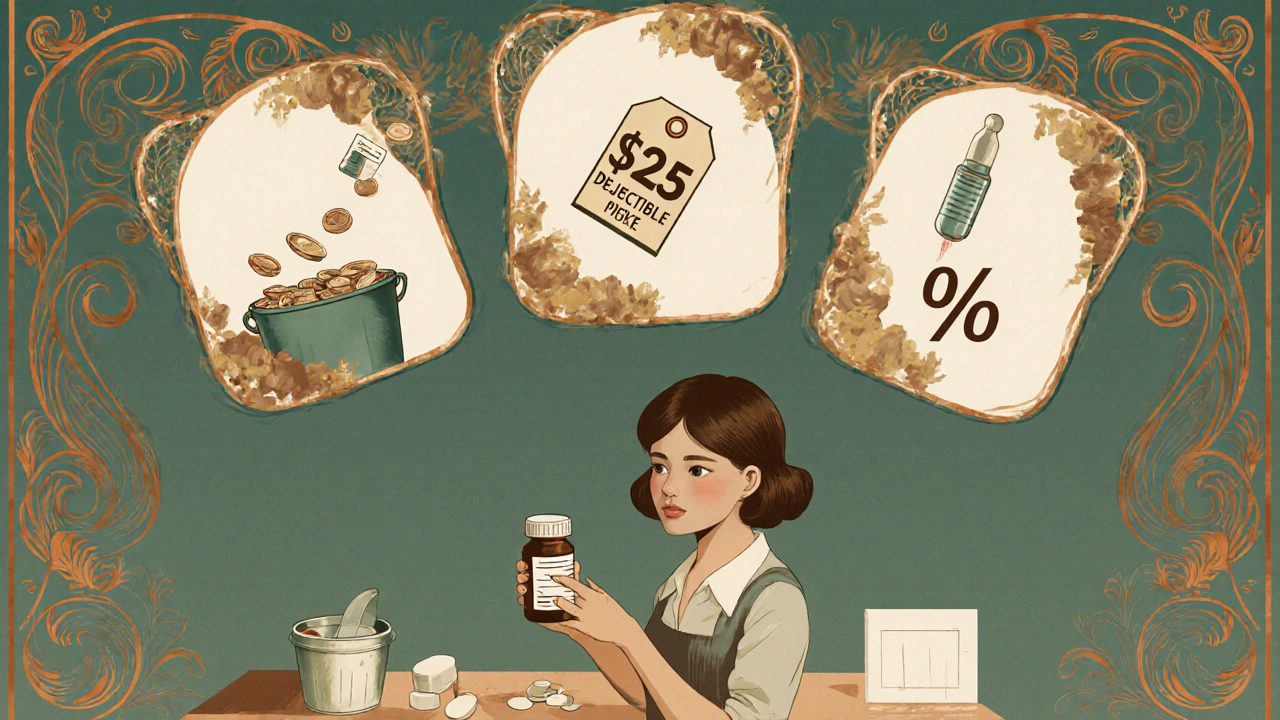When you fill a prescription, pick up your insulin, or get a specialty medication, you might be surprised by how much you’re expected to pay - even with insurance. That’s because most health plans don’t cover everything. Instead, they split the cost with you. This split is called cost sharing. It’s not complicated, but it’s often confusing. Deductibles, copays, and coinsurance are the three main pieces of this puzzle. Understand them, and you’ll stop getting shocked by your pharmacy bill.
What’s a Deductible? The First Hurdle
Your deductible is the amount you pay out of pocket before your insurance starts helping with most costs. Think of it like a bucket. You fill it with your own money until it’s full. Then, and only then, does your insurance kick in for covered services - including medications. For example, if your plan has a $2,000 deductible, you pay the full price for your prescriptions until you’ve spent $2,000 on covered care in a year. That includes doctor visits, lab tests, and your meds. Once you hit that number, your insurance starts paying a portion of future costs. Not all services count toward your deductible. Preventive care - like annual check-ups or flu shots - often doesn’t. And under the Affordable Care Act, many preventive medications (like birth control or certain vaccines) are covered at $0 cost, even before you meet your deductible. High-deductible plans (HDHPs) are common now. In 2023, the average individual deductible was around $1,945, up from just $1,170 in 2010. These plans usually have lower monthly premiums, but you pay more upfront when you need care. If you’re healthy and rarely take meds, this might make sense. If you’re on chronic medication, you could hit your deductible quickly - or struggle to afford it.Copays: Fixed Fees at the Pharmacy
A copay is a flat fee you pay each time you get a service. For prescriptions, it’s usually $10, $25, or $45 per fill. You pay this at the counter, no matter what the actual cost of the drug is. Copays are simpler than deductibles. You don’t need to track how much you’ve spent so far. You just pay the fixed amount every time you pick up your medication. But here’s the catch: copays don’t always apply until after you meet your deductible. Some plans require you to pay full price for meds until your deductible is met, then switch to copays. Others let you use copays right away - even before you’ve paid your deductible. It depends on your plan. Plans often have different copay tiers for different drugs:- Tier 1: Generic drugs - $5 to $15
- Tier 2: Preferred brand-name drugs - $25 to $45
- Tier 3: Non-preferred brands - $50 to $75
- Tier 4: Specialty drugs - $100+ (think biologics for arthritis or cancer)
Coinsurance: The Percentage Game
Coinsurance is where things get tricky. It’s not a fixed amount. It’s a percentage. After you meet your deductible, you pay a share - usually 20% or 30% - of what your drug costs. Your insurance covers the rest. Say your insulin costs $120, and your coinsurance is 20%. You pay $24. Your insurer pays $96. But if that same insulin costs $300 (because of a price hike or out-of-network pharmacy), you pay $60. Coinsurance goes up with the price. That’s why it can be risky. You might think you’re covered, then get a bill for $150 because your drug got more expensive. Coinsurance often applies to specialty drugs. If you’re on a biologic for rheumatoid arthritis, you could be paying 30% of $8,000 a month - that’s $2,400. No wonder people skip doses or skip refills. The good news? Coinsurance payments count toward your out-of-pocket maximum. So even if you’re paying hundreds a month, there’s a cap. Once you hit it, your insurance pays 100% for the rest of the year.
Out-of-Pocket Maximum: The Safety Net
This is the most important number you need to know. It’s the most you’ll pay for covered care in a year - including your deductible, copays, and coinsurance. After you hit this limit, your plan pays 100% for everything else. In 2023, the federal cap was $9,100 for individuals and $18,200 for families. Some plans have lower limits. But none can go higher than that. Here’s how it works in real life: You have a $3,000 deductible, $40 copays for generics, and 30% coinsurance for your biologic. You take three specialty drugs. By September, you’ve paid $8,900. October comes. You need another refill. You pay $0. Your insurance covers it. Full stop. Many people don’t realize copays and coinsurance count toward this cap. They think only their deductible does. That’s a dangerous misunderstanding. Always check your Explanation of Benefits (EOB) - it shows you how close you are to hitting your max.What Doesn’t Count as Cost Sharing?
Not every payment you make is part of cost sharing. Premiums - the monthly fee you pay to keep your insurance active - don’t count. Neither do charges for services your plan doesn’t cover. If your plan doesn’t cover a certain drug, you pay full price, and it doesn’t help you reach your deductible or out-of-pocket max. Also, out-of-network care can be a trap. If you fill a prescription at a pharmacy that’s not in your plan’s network, your coinsurance might jump from 20% to 50%. Or worse - your plan might not cover it at all. Always use in-network pharmacies. Most insurers have apps or websites that let you find them.
How to Manage Your Costs
You can’t control drug prices, but you can control how you respond to them.- Use your insurer’s online cost estimator. Many let you compare prices for your meds across pharmacies. You might save $100 a month just by switching.
- Ask your doctor about generic alternatives. A 2022 study found that 80% of brand-name drugs have cheaper generic versions with the same effect.
- Check for manufacturer coupons or patient assistance programs. Many drugmakers offer discounts for people who can’t afford their meds - even if you have insurance.
- Review your plan’s formulary every year during open enrollment. Plans change what they cover. A drug you got for $20 last year might now be $150.
- Call your insurer before filling a new prescription. Ask: “What’s my cost-sharing? Is this in-network? Will it count toward my out-of-pocket max?”
Recent Changes That Affect You
The Inflation Reduction Act of 2022 capped insulin costs at $35 per month for Medicare beneficiaries. That’s huge. But if you’re on private insurance, that cap doesn’t apply - yet. Some states, like California and Colorado, have passed similar laws for private plans. Check your state’s rules. Also, the No Surprises Act (2022) protects you from surprise bills for emergency care. If you get treated in an ER and your insulin is administered there, you can’t be charged out-of-network rates. That rule doesn’t cover routine prescriptions, but it shows regulators are paying attention. By 2025, more plans will use “value-based design.” That means lower cost-sharing for high-value drugs (like blood pressure meds) and higher cost-sharing for low-value ones (like unnecessary antibiotics). It’s meant to encourage smarter care. But it also means you’ll need to be even more aware of what’s covered and why.Final Tip: Know Your Plan
Your Summary of Benefits and Coverage (SBC) document is your best friend. Every insurer must give you one. It shows real examples: “If you need a prescription for this drug, here’s how much you’d pay.” Read it. Keep it. Compare it every year. You’re not alone if this feels overwhelming. A 2022 survey found that 68% of people didn’t understand how their deductible differed from their out-of-pocket max. But you’re reading this - that means you’re already ahead. Start small. Next time you pick up your meds, check your receipt. See what you paid. Was it a copay? Coinsurance? Did it count toward your max? Track it for a month. You’ll start seeing patterns. And you’ll stop being surprised by your bills.What’s the difference between a deductible and a copay?
A deductible is the total amount you pay each year before your insurance starts helping with most costs. A copay is a fixed fee you pay each time you get a service - like picking up a prescription. You pay the deductible first, then copays may apply afterward, depending on your plan.
Do copays count toward my out-of-pocket maximum?
Yes, copays usually count toward your out-of-pocket maximum - along with your deductible and coinsurance. Once you hit that limit, your insurance pays 100% of covered services for the rest of the year. Always check your plan’s details to confirm.
Why do I pay more for some medications than others?
Insurers group drugs into tiers. Generic drugs are cheapest. Brand-name drugs cost more. Specialty drugs - like those for cancer or autoimmune diseases - are the most expensive. Your plan’s formulary determines which tier your drug is in, and that sets your copay or coinsurance rate.
Can I avoid coinsurance on expensive drugs?
Sometimes. Ask your doctor about generic alternatives. Check if your drugmaker offers coupons or patient assistance programs. Some states cap out-of-pocket costs for certain meds. And if you’re on Medicare, insulin is capped at $35/month. Always ask your insurer: “Is there a cheaper option that’s covered the same way?”
What happens if I go to an out-of-network pharmacy?
You’ll likely pay more. Your coinsurance percentage may increase, or your plan might not cover the drug at all. You could also be charged a higher retail price. Always use in-network pharmacies - they’re listed on your insurer’s website or app. It’s worth the extra minute to check.







Kane Ren
November 21, 2025 AT 22:39Just wanted to say this is one of the clearest explanations I’ve ever read. I’ve been on insulin for 8 years and never understood why my bill jumped from $24 to $60 one month-now I get it. Coinsurance is a sneaky beast.
Thanks for breaking it down without jargon. This should be mandatory reading for everyone with insurance.
Charmaine Barcelon
November 23, 2025 AT 22:15Ugh. I hate how people act like this is some groundbreaking revelation. Everyone who’s had insurance for more than 2 weeks knows this. Why are we still talking about this like it’s 2010?
Also, generic drugs aren’t always the same. I had a seizure once from a bad generic. So don’t just ‘switch’ like it’s a grocery list.
Richard Wöhrl
November 23, 2025 AT 23:20Charmaine-your comment is valid, but let’s not dismiss the value of clarity. Many people, especially new to chronic care or navigating Medicare/Medicaid, genuinely don’t know the difference between deductible and out-of-pocket max.
And yes, generics can vary. But the FDA requires them to be bioequivalent. If you had a reaction, it might’ve been an inactive ingredient-tell your pharmacist. They can often switch you to a different manufacturer’s version.
Also, if you’re on a specialty drug, ask about a specialty pharmacy. They often have better cost-sharing support.
Karla Morales
November 25, 2025 AT 16:06📉📊📊📊📊📉
Let’s be real: the entire system is designed to confuse. The fact that we’re still having this conversation in 2025 proves healthcare is a profit engine, not a public good.
And yes, I know the Inflation Reduction Act capped insulin-but only for Medicare. Private insurers? Still gouging. And no, your ‘copay assistance’ isn’t charity-it’s a tax write-off for them.
Also, your ‘formulary’? It’s a marketing document. The drug companies pay the insurers to put their expensive meds on Tier 2. You’re being manipulated.
Stop blaming yourself. The system is rigged.
Pramod Kumar
November 27, 2025 AT 14:38Bro, I’m from Mumbai and we don’t even have insurance here-but I read this because my cousin in Texas sent it to me. She’s on a $2,400/month biologic and cried when she saw the coinsurance math.
Man, you made it so simple. I told her to check if her drug is on the 340B list-some US hospitals offer discounts if you’re low-income, even with private insurance. She didn’t even know that existed.
Also, she’s now using GoodRx. Saved her $180/month. Not perfect, but it’s something.
Thanks for writing this. It’s a lifeline.
Suresh Ramaiyan
November 29, 2025 AT 08:58There’s something deeply human about how we’re forced to become financial analysts just to afford medicine.
We’re not supposed to need a spreadsheet to stay alive. But here we are.
Maybe the real problem isn’t that we don’t understand cost-sharing-it’s that we’ve been taught to accept it as normal.
I wonder what a world would look like where health wasn’t a transaction, but a right.
Still-thank you for the practical tips. Knowledge is power, even in a broken system.
Olanrewaju Jeph
November 29, 2025 AT 20:44This is excellent. I’ve worked in Nigerian public health for 12 years, and I’ve never seen such a clear breakdown of U.S. insurance mechanics. The tiered copay system is alien to us-we either pay full price or nothing.
But your advice on formularies and in-network pharmacies? Universal. People everywhere need to know how to navigate systems that aren’t designed for them.
Thank you for making this accessible. I’m sharing this with my patients who’ve moved to the States.
Katy Bell
December 1, 2025 AT 16:03Okay I just cried reading this. Not because I’m sad-because I finally get it.
I’ve been paying $175 for my thyroid med every month and thought I was being ‘charged extra.’ Turns out it was coinsurance and I was only at $6,200 of my $9,100 max.
So I called my insurer. They confirmed: next refill is $0. I’m not paying another dime until January.
Thank you. I feel like I’ve been given a secret weapon.
shreyas yashas
December 3, 2025 AT 02:59man i just started taking my first med this year and i was lost af
thanks for this. i printed it out and stuck it on my fridge next to my pill organizer
now i know why my receipt says 'coinsurance' and not 'copay' lol
Dalton Adams
December 3, 2025 AT 17:52Wow. This is basic. Like, 101-level. If you’re reading this and still confused, you probably shouldn’t be managing your own healthcare. Maybe get a case manager?
Also, stop using GoodRx. It’s a band-aid. Real solution? Single-payer. But no, let’s keep treating symptoms while the system burns.
And FYI-'value-based design' is just corporate speak for 'we’re gonna punish you for being sick.'
Also, your 'Summary of Benefits'? It’s written by lawyers who think you’re an idiot. Read it with a highlighter and a lawyer friend. Or don’t. Just keep paying.
Brandy Walley
December 5, 2025 AT 17:00Why do we even have insurance if we still pay so much? Just take the money out of our paychecks and give us cash. At least then we’d know what we’re spending.
Also, I don’t trust doctors. They’re paid to push expensive drugs. I stopped taking mine. My blood pressure’s fine. I just drink lemon water now.
And no, I don’t need to see a specialist. I’m not broken. The system is.